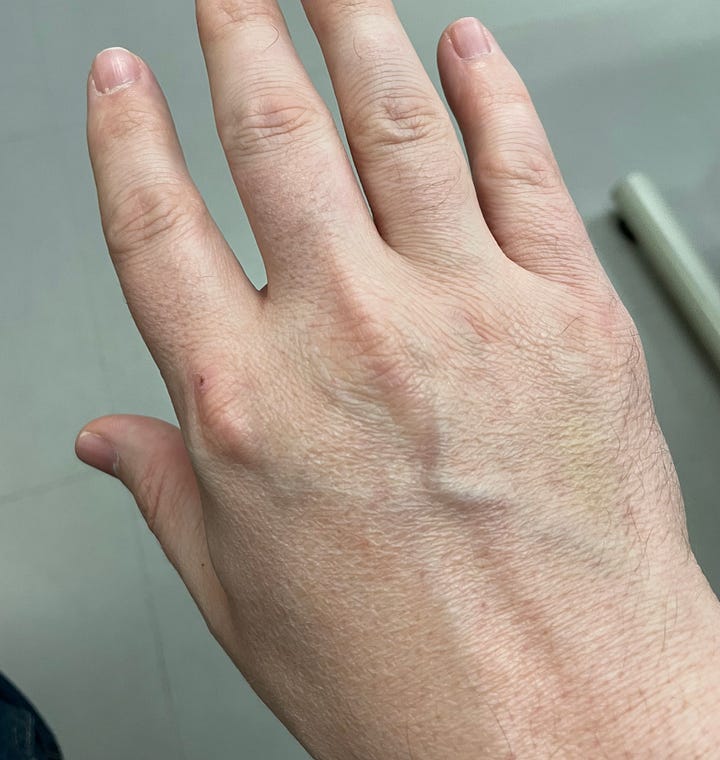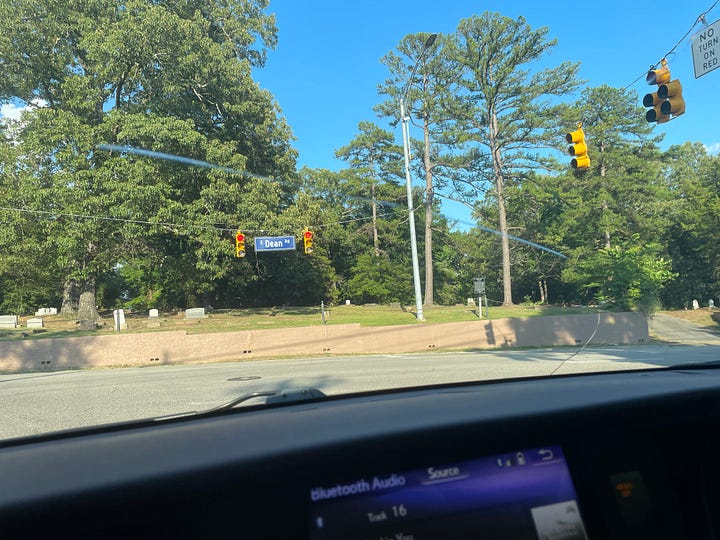Convalescence
Thoughts on maintenance and repair
Two weeks ago I was discharged from the hospital. At that time, walking around the house for too long was tiring, and I still had a wicked cough. I took the next week off to rest and recover. Twenty minute walks increased to 30 and then 40 minutes. Last Sunday I was able to return to the gym, albeit at a low intensity.
Now I’m slowly returning to work, back on locum and digging through overdue emails and presentations. My cough is all but gone and I have more energy. No more sneezing or runny nose. Last night, I was able to complete an hour-long Orange Theory fitness class. While my speeds were slower and I had to drop my weights down significantly, I was still able to jog 2 miles, row 1,000 meters, and do 20 minutes of resistance training.
Even the physical marks from my illness are vanishing. The large bruises over multiple veins have faded to the point where you can hardly see them:


When I was a kid, I remember learning that salamanders could regenerate entire limbs that were lost. It felt deeply disappointing that much more advanced animals like cats, dogs, and people could accomplish no such feat. After years of studying disease at the cellular level I am amazed at the magnificent ability of our bodies to bounce back from everything from fractures to infections.
The simplest insult to our body—say, a paper cut—triggers an immediate symphony of coordinated signals that mobilizes cells to repair the defect and ward off invaders. First, the blood vessels in the immediate area constrict to limit bleeding. Then, little cellular fragments called platelets arrive at the site and begin to form a loose plug. Clotting proteins in your bloodstream begin to form a stronger mesh around the platelet scaffold. At this point, blood vessels begin to dilate—causing the characteristic redness of inflammation—to bring white blood cells to the site of injury to fight the bacteria streaming in, and they stick to the clot like security guards. Molecules called cytokines start mobilizing longer-term defenses like macrophages and lymphocytes. Your body pumps out antibodies to the pathogens it encounters. They signal fibroblasts and epithelial cells in the local tissues to repair the defect by bringing the edges of the wound together and forming new tissue.

More complicated problems like pneumonia obviously take longer to resolve than a paper cut. This healing process picks-up where the other one leaves off, with inflammatory cells rushing into the alveoli (the small air sacs in your lungs) to destroy bacteria, and also causing collateral damage in the process. As the infection clears, anti-inflammatory signals tamp down the immune response, allowing local respiratory epithelial cells to proliferate and repair these tissues over weeks to months. A CT scan of my chest taken today would likely show airways that are still mildly inflamed and filled with fluid. But I find it amazing that with no conscious effort on my part, lung tissue that two weeks ago looked like a gnarled rats nest of pus and bacteria has already healed sufficiently to the point where I can run two miles. If that isn’t miraculous, I don’t know what is.
The day before I drove myself to the hospital, I woke up to find a huge crack in my car’s windshield. No idea what caused it. Perhaps like my pneumonia episode, there was some underlying weakness that allowed a small catalyst to break the whole thing. This really bummed me out. As if I didn’t have enough on my plate already, now I had to worry about car repairs.
Fixing the problem turned out to be less dramatic than I expected. A couple calls to local auto glass shops later and a technician was in my driveway exchanging the windshield for a new one (the crack was far too large for a smaller repair). The whole process took less than thirty minutes and it was covered by my insurance.


So often in life, we seek quick fixes to our problems. If the car needs too much work, we consider buying a new one. If there’s trouble in our job, we apply elsewhere. Don’t like where you live? Move! While sometimes starting fresh is the best option, and I wouldn’t judge someone for leaving a toxic situation to improve their life, we often overlook the value of staying put and working through challenges. Our bodies, much like cars, have a remarkable capacity for recovery, and regular maintenance can keep both running longer. Unlike mechanical objects, we don’t have another option: we only get one body and we have to make it last.
The past few weeks have shown me the value of such unglamorous maintenance and repair. Entering this illness with a strong baseline level of fitness undoubtedly helped me recover more quickly. Gradually pushing myself to run farther and lift harder will rebuild the muscles that atrophied. Despite spending much of the last 38 years neurotically trying to avoid sickness or damaging anything I own, this brush with a serious illness showed me there is less to be afraid of than I thought.
Wounds heal. What is broken can be made whole again. Things will be OK.






Hey, I just wanted to tell you this post was relevant on so many levels. Great immune system tutorial, too! I am very glad you're doing so much better. Keep on getting well!
Godspeed and glad ur on the mend!